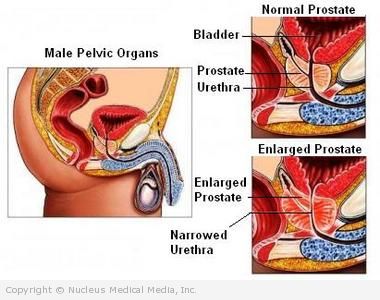Benign prostatic hyperplasia
(BPH; Benign Prostatic Hypertrophy; Prostatism; Bladder Outlet Obstruction)
Benign prostatic hyperplasia – Definition
Benign prostatic hyperplasia (BPH) is an enlargement of the prostate. The prostate is usually a walnut-sized gland located at the neck of the bladder. It surrounds the urethra. The gland is part of the male reproductive system. The enlargement is not due to cancer.
Benign prostatic hyperplasia – Causes
The exact cause of BPH is unknown. It may be related to changes in hormone levels as men age. Eventually, the prostate becomes so enlarged that it puts pressure on the urethra. This causes the urethra to narrow or close completely.
Benign prostatic hyperplasia – Risk Factors
A risk factor is something that increases your chance of getting a disease or condition. The main risk factor for BPH is being over 50 years old.
Benign prostatic hyperplasia – Symptoms
Narrowing of the urethra caused by growth of the prostate causes the symptoms of BPH. Symptoms usually increase in severity over time.
Symptoms include:
- Difficulty starting to urinate
- Weak urination stream
- Dribbling at end of urination
- Sensation of incomplete bladder emptying
- Urge to urinate frequently, especially at night
- Deep discomfort in lower abdomen
- Urge incontinence
Benign prostatic hyperplasia – Diagnosis
BPH diagnosis is based on:
- Your age
- Symptoms
- Digital rectal exam — the doctor inserts a gloved finger into the rectum to examine the area
Other tests may include:
- Urine flow study
- Cystometrogram (a functional study of the way your bladder fills and empties)
- X-ray of the urinary tract
- Transrectal ultrasound
- Post-void residual volume test — measures whether you can empty your bladder completely
- Cystoscopy — this test allows a doctor to look inside the urethra and bladder
Testing for prostate specific antigen (PSA) is often used to screen for prostate cancer. However, BPH may cause a lesser elevation in PSA levels. This can raise false concerns about the presence of cancer.
Benign prostatic hyperplasia – Treatment
Treatment is not needed for mild cases. Most men with BPH eventually request medical intervention.
Treatments include:
Medication
Medicines prescribed to treat BPH include:
- 5 alpha-reductase inhibitors ( finasteride, dutasteride) — These drugs are taken to improve symptoms, like the urge to urinate frequently and difficulty starting to urinate.
- Alpha-blockers (eg, tamsulosin, alfuzosin, doxazosin, terazosin) — These drugs are taken to reduce bladder obstruction and improve urine flow.
- Antimuscarinics ( oxybutynin, solifenacin, tolterodine, darifenacin, trospium, fesoterodine) — These drugs are taken to relax the bladder muscles, which helps to reduce the urge to urinate frequently.
- Phosphodiesterase-5 enzyme inhibitor ( tadalafil [Cialis]) — This erectile dysfunction drug can also be prescribed to improve the symptoms of BPH.
- Note: You should not take tadalafil if you are also taking nitrates (eg, nitroglycerin) because your blood pressure may become dangerously low. Also, tadalafil should not be taken in combination with alpha blockers.
Each group of medicines have different side effects. Enzyme inhibitors may cause decreased sexual desire and problems with erection. Alpha-blockers may cause decreased blood pressure, dizziness, and stuffy nose. Antimuscarinics can cause dry mouth, constipation, dry eyes, trouble emptying the bladder, and confusion.
If you have BPH, you should not take decongestant drugs containing alpha-agonists (eg, pseudoephedrine). These drugs can worsen BPH symptoms.
Minimally Invasive Interventions
These are used when drugs are ineffective, but the patient is not ready for surgery. Nonsurgical treatments include:
- Transurethral microwave thermotherapy (TUMT) — uses microwaves to destroy excess prostate tissue
- Transurethral needle ablation (TUNA) — uses low levels of radio frequency energy to burn away portions of the enlarged prostate
- Transurethral laser therapy — uses highly focused laser energy to remove prostate tissue
Surgery
Surgical procedures include:
- Transurethral surgical resection of the prostate (TURP) — a scope is inserted through the penis to remove the enlarged portion of the prostate
- Transurethral incision of the prostate (TUIP) — small cuts are made in the neck of the bladder to widen the urethra
- Open surgery — removal of the enlarged portion of the prostate through an incision, usually in the lower abdominal area, much more invasive then TURP or TUIP
- Prostatic stents — tiny metal coils that are inserted into urethra to widen it and keep it open
- Usually used for men who do not wish to take medication or have surgery
- Do not appear to be a good long-term option
Alternative Treatments
Examples of herbal products that have been studied as a possible BPH treatments include:
- Saw palmetto — Results from studies vary on how useful saw palmetto is in reducing symptoms.
- Beta-sitosterol — Some studies suggest that this may help reduce symptoms.
- Pygeum — Some studies suggest that this may help reduce symptoms.
If you are diagnosed with BPH, follow your doctor’s instructions.
Benign prostatic hyperplasia – Prevention
Prostate enlargement occurs naturally with age. There are no specific prevention steps.

